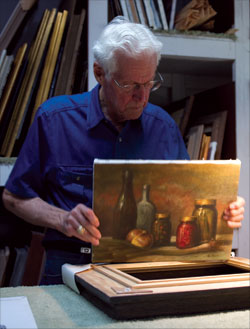
Table of Contents
Features
Agriculture: We Can Sustain It
Socializing Agriculture
Painter of Quiet Places
An Apple a Day
Sustaining the Four Sixes
Hitting Pay Dirt
The New Face of Agriculture
The Winds of Change
Avatars Animate Agriculture
Professors in Training
Going Green
Saving Lives One Plan at a Time
Protecting Our Food
Quality Cells, Consumer Buys
Tech's New Mate
Micro ZAP
Food Saftey in Mexico
Expanding Opportunities
No Bits About It
The Family Farm Fire Man
Around the World with CASNR
Live From Texas Tech
Looking Forward
Getting Schooled
A Cotton Senstaion
Living and Learning
More Than a Trophy
Online Exclusives
Alumni Lance Barnett: Unpeeled
Agricultural Education and CommunicationDepartment Shines in 2010
CSI: Classroom Soil Investigation
Facing Nature
GINuine
Healing Hooves
Parking and Partying in Style
Raider Red Meats
Standing TALL
Tech Takes Flight
West Texas Cotton Goes Global
A Painter of Quiet Places
By Clayton Wilson

After World War II, a young veteran enrolled at the newly bustled Texas Tech University, then known as Texas Technical College. Four years later, in 1950, he graduated and moved on to become head of the Army graphics section. At eighty-six years old, Al Moore has transitioned from drawing war illustrations to painting the peaceful Texas Hill Country.
Inspired by his childhood on the family’s farm in Temple, Texas, Moore enjoys painting the Texas hill country as well as imagery from experiences on horseback, working cattle and farming.
“I grew up working on the farm,” Moore said, “and running around the woods as a boy.”
In 1942, the U.S. Army purchased most of the Moore family farm to build an airport in preparation for the war. The family then moved to a 1,200-acre plot of land in Comanche Gap where they continued to farm and ranch. In 1944, Moore decided to join the Air Force and was given a position in the repair depot.
“I was supposed to be a gunner in one of the planes,” Moore explained, “but I was too tall to fit inside, so they just sent me to the repair depot.”
After the war ended, Moore was one of many veterans who aspired to get a college education. He knew he wanted to study commercial art, so he eventually chose to attend Texas Tech.
“It was perfect,” Moore said. “They offered exactly what I was looking for and I had relatives that lived in Lubbock.”
Once he had completed his education, Moore took some time to explore various career opportunities. Eventually, he enlisted in the Army as head of the graphics section. Moore’s drawings were used to train and brief Army generals all over the world. Some drawings helped explain foreign terrain to American soldiers, others detailed the schematics of enemy tanks and armored guns, and still others outlined intricate webs of possible booby traps. Some of his artwork was even seen by presidents or leading generals.
“You always cringed when you heard the President or a major general was coming,” Moore said. “It usually meant you had to have something drawn and prepared right away.”
Moore recalls once working quickly to interpret images of a new Soviet tank for training. The irony was, after the men actually got into the field, the tank looked nothing like the “top secret” illustrations he was given. He emphasized some of his work really was top secret, need-to-know only information.
“I had to draw locations of Russian troops that were kept in a vault,” Moore recalled.
Moore’s artistic repertoire mainly consisted of war illustrations until after he retired from the Army in 1982. Then, Moore was able to focus more on his passion for painting. And many of his subjects were memories inspired by his beloved Texas hill country.
“I paint the things I see,” Moore said, “and take inspiration from all of God’s creation.”
Moore’s wife, Irene, has spent 58 years supporting Al Moore’s passion for art. She said she considers her husband to be among some of the great Texas western painters and credits his talent to his passion.
“He likes to show how he feels about the world through the pictures that he paints,” Irene Moore said.
Since retirement, Al Moore has spent time helping another generation of artists by teaching an art class in Belton, Texas, as well as conducting various workshops and demonstrations of his technique across the state.
Many of Moore’s paintings can be found in the small Texas towns like Fredericksburg, Salado, and now at the Creekside Gallery in Belton.
Some of his pieces have even been purchased internationally, as there is an Al Moore original hanging in the Officers Club of the Royal Air Force in England.
“I paint because I need to,” Moore explained. “Painting is not a job, but a joy, and I can’t imagine retiring from painting.”
Moore truly believes his abilities are a gift from God. He will be the first to tell you his successes are a blessing from above and not from his own doing. Moore concisely explained where he credits his talents.
“I think that for some reason God gave me the talent and desire to observe the wonders of his creation and to try to create, in a human way, a picture of my vision.”